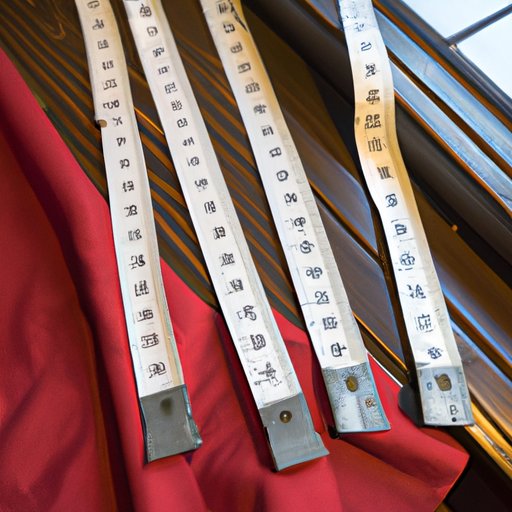
I. Introduction
One of the easiest ways to spruce up a room is by adding curtains to your windows. They provide privacy, add a pop of color, and create a cozy ambiance. But before you can enjoy these benefits, you need to know how to hang a curtain rod properly. This may seem like an intimidating task, but with the right tools and guidelines, anyone can do it. This article will provide you with all the information you need to confidently hang your curtains and enjoy your new window treatments.
II. Materials needed
Before we dive into the step-by-step guide, let’s go over the materials needed for hanging a curtain rod. You will need:
- Measuring tape
- Pencil
- Level
- Drill
- Screws
- Wall anchors (if necessary)
- Curtain rod
- Brackets
III. Step-by-step guide to hanging a curtain rod
Now that you have all the required materials, it’s time to hang the curtain rod. Follow these step-by-step instructions:
A. Measuring the width of the window
First, measure the width of your window. It’s best to add a few extra inches on either side of the window frame to allow the curtains to hang nicely without blocking any natural light. Next, measure the height of the window and decide where you want the curtains to fall. Typically, curtains hang about 4-6 inches above the window frame.
B. Marking the spots for drilling
Use a pencil to mark where you want to drill. For best results, use a level to make sure the markings are straight. If your curtains have rings, place them on the rod before attaching the brackets.
C. Screwing the brackets in the right places
Next, drill small pilot holes where you marked the spots. Then, use the screws to attach the brackets. If the brackets are too loose or wobbly, consider using wall anchors for added stability.
D. Attaching the rod
Slide the rod through the rings or place it onto the brackets. Make sure the rod is level and centered on the window before tightening any screws.
E. Hanging the curtains
Finally, hang your curtains on the rod. Adjust the length and fullness of the curtains to your liking.
IV. Tips for balance and symmetry
One of the challenges of hanging a curtain rod is ensuring that it looks balanced and symmetrical. Here are some tips to help you achieve this:
A. How to ensure the rod is level
To ensure the rod is level, use a spirit level. If you don’t have a spirit level, place a long, straight object such as a broomstick on the rod. Make sure it’s equidistant from the window frame on either side. Adjust the brackets as necessary.
B. How to ensure the curtains are balanced and symmetrical
If your curtains have rings, make sure they’re evenly spaced. For curtains without rings, use curtain clips or drapery pins to ensure that the folds are evenly distributed.
V. Different types of curtain rods
There are a variety of curtain rods to choose from. Here are some different types:
A. Explanation of different types of curtain rods
- Standard rods: These are the most basic curtain rods, available in a variety of materials and lengths.
- Decorative rods: These are typically more ornate and come in a variety of finishes to match your decor.
- Tension rods: These don’t require drilling and are suitable for smaller or lightweight curtains.
- Traverse rods: These allow curtains to be opened and closed using a cord system.
B. Suggestions on which types of curtain rods work best for different windows and curtains
The type of rod you choose will depend on your window size and the weight and style of your curtains. Standard or decorative rods work well for most situations. Tension rods are ideal for smaller windows or lightweight curtains. Traverse rods are a good choice for heavier drapes or curtains that need to be opened and closed frequently.
VI. Considering the weight of the curtains
Heavier curtains require sturdier brackets and screws to prevent the rod from falling. Here are some suggestions for brackets and screws:
A. Types of brackets appropriate for heavier curtains
Brackets labeled as “heavy-duty” or “double-rod” are ideal for heavier curtains.
B. Types of screws appropriate for heavier curtains
Choose screws that are at least 1.5 to 2 inches long and have a wider diameter than the screws typically included with curtain rods.
VII. Troubleshooting common problems
Here are some common problems that may arise when hanging a curtain rod and how to fix them:
A. Troubleshooting tips for common problems with hanging curtain rods
- If the screws won’t stay in the wall, try using wall anchors.
- If the brackets are too loose, try tightening the screws or using wall anchors.
- If the rod is drooping in the middle, it may not be strong enough to support the weight of your curtains. Consider replacing the rod with a sturdier one.
B. Tips for fixing problems with a falling rod or sliding curtains
- If the rod is falling, check that the brackets are securely fastened to the wall and that the rod is properly centered on the window.
- If the curtains are sliding along the rod, consider adding rubber stoppers or using curtain rings with clips.
VIII. Conclusion
Now that you know how to hang a curtain rod like a pro, it’s time to beautify your windows and enjoy the benefits of your new window treatments. Remember to measure carefully, use the right materials, and follow the step-by-step guide. With a little patience and attention to detail, you’ll have beautiful curtains that will enhance the ambiance of your home.





